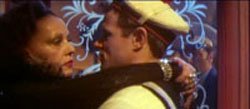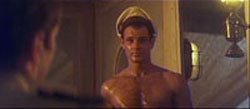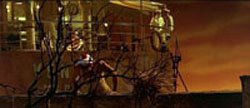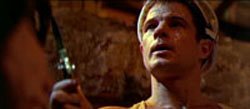The stars of Berlin: Rainer Werner Fassbinder - Querelle







REFERENCE : FILM - Querelle by Rainer Werner Fassbinder
Querelle (1982)
Directed by Rainer Werner Fassbinder
Written by Fassbinder & Burkhard Driest, based on Jean Genet's novel, Querelle de Brest
Production Design by Rolf Zehetbauer
Art Direction by Walter E. Richarz
Costume Design by Barbara Baum & Monika Jacobs
Original Music by Peer Raben
Choreography by Dieter Gackstetter
Dedicated to El Hedi ben Salem
Cast:
Brad Davis as Querelle, Franco Nero as Lieutenant Seblon, Jeanne Moreau as Lysiane, Laurent Malet as Roger Bataille, Hanno Pöschl as both Robert and Gil, Günther Kaufmann as Nono, Burkhard Driest as Mario
Also Known As:
Querelle (UK) (USA) Querelle - Ein Pakt mit dem Teufel
Runtime: 108 min
Country: West Germany / France
Language: German
Colour: Colour
Sound Mix: Dolby
Querelle, is definitely Fassbinder's greatest, and most labyrinthine, works. It is poignant to realize that this film, which reaches a new, albeit horrific, aesthetic peak for Fassbinder was also his last work. On June 10, 1982 he died from a heart attack caused by sleeping pills and cocaine, after he had finished the picture's editing but before its premiere.
Querelle is the tale of a beautiful, proud and hard-as-nails loner, the sailor Querelle, whose commanding officer, Lieutenant Seblon, is obsessed with him.
Querelle turns on his drug-smuggling partner and murders him. He goes to a notorious brothel run by the rapacious Lysiane, who leads him into his first homosexual encounter, with her husband Nono. Lysiane is madly in love with Querelle, but takes his brother Robert as a substitute. Robert and Querelle have an incestuous relationship, which they try to hide. Later, Querelle falls in love with a fellow murderer, Gil, who bears an uncanny resemblance to his brother. Gil is having an affair with an angelic young man named Roger. Querelle's increasing passion for Gil, the first man he has loved, panics him, so he betrays him to the police. But by now Querelle has become vulnerable, and he at last allows himself to submit to Seblon.
Querelle is Fassbinder's most luridly experimental film, filled with his extremes of visual design and debauched characters. It's as if he had gone down into a maelstrom of operatic emotion (say, Wagner's Tristan und Isolde, Strauss's Salome, Berg's Wozzeck – Fassbinder was an opera devotee), and then transformed that passion into shattering images; his extremes of colour and composition are like the most intense music made flesh.
The film is based on Jean Genet's novel, Querelle de Brest, and its anachronistic shocks are as intention as Fassbinder's revolutionary extremes, even for him, image and sound: as he states, on a title card in the opening credits, this is a film about Genet's novel, not a mere picturization.
I consider Genet one of the greatest novelists and playwrights of the last century; Fassbinder captures the fever-dream quality of Genet's decadent prose poetry, through his impossibly garish lighting and bizarre sets (how many forts boast ten-foot-tall phalluses as both strategic defence barriers and ornamentation). But more than Genet, this picture is unmistakably Fassbinder.


0 Comments:
Post a Comment
<< Home